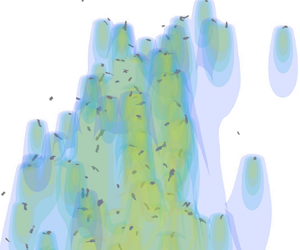No CrossRef data available.
Published online by Cambridge University Press: 19 December 2024

Hydrodynamic interactions between swimming or flying organisms can lead to complex flows on the scale of the group. These emergent fluid dynamics are often more complex than a linear superposition of individual organism flows, especially at intermediate Reynolds numbers. This paper presents an approach to estimate the flow induced by multiple swimmer wakes in proximity using a semianalytical model that conserves mass and momentum in the aggregation. The key equations are derived analytically, while the implementation and solution of these equations are carried out numerically. This model was informed by and compared with empirical measurements of induced vertical migrations of brine shrimp, Artemia salina. The response of individual swimmers to ambient background flow and light intensity was evaluated. In addition, the time-resolved three-dimensional spatial configuration of the swimmers was measured using a recently developed laser scanning system. Numerical results using the model found that the induced flow at the front of the aggregation was insensitive to the presence of downstream swimmers, with the induced flow tending towards asymptotic beyond a threshold aggregation length. Closer swimmer spacing led to higher induced flow speeds, in some cases leading to model predictions of induced flow exceeding swimmer speeds required to maintain a stable spatial configuration. This result was reconciled by comparing two different models for the near-wake of each swimmer. The results demonstrate that aggregation-scale flows result from a complex, yet predictable interplay between individual organism wake structure and aggregation configuration and size.